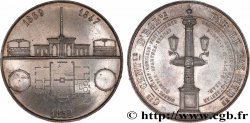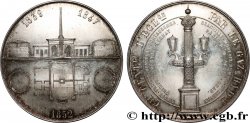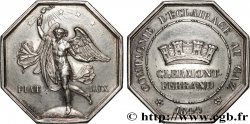fjt_1025437 - GAZ (L'ÉCLAIRAGE AU...) Jeton octogonal Ar 32, compagnie d’éclairage au gaz de Vérone n.d.
180.00 €
Quantità
Aggiungi al carrello

Tipo : Jeton octogonal Ar 32, compagnie d’éclairage au gaz de Vérone
Data: (1845-1860)
Data: n.d.
Metallo : argento
Diametro : 32,5 mm
Asse di coniazione : 12 h.
Peso : 13,92 g.
Orlo : lisse
Marchio : main indicatrice (1845-1860) et ARGENT
Grado di rarità : R1
Commenti sullo stato di conservazione:
Patine grise hétérogène, un peu sombre, présentant de l’usure sur les reliefs. Présence de quelques coups et rayures
Diritto
Titolatura diritto : COMPAGNIE D'ÉCLAIRAGE AU GAZ.
Descrittivo diritto : Allégorie tenant un flambeau au-devant d’un paysage industriel ; signature SALMSON F..
Rovescio
Titolatura rovescio : VILLE DE VERONE.
Descrittivo rovescio : Écu aux armes de la ville sur un feuillage et couronné, signature SALMSON. F..
Commento
Le gaz naturel était connu depuis l'Antiquité notamment en Perse mais ce n'est qu'à la fin du XVIIIe siècle que l'idée d'un éclairage au gaz apparut. Le procédé ne se répandit que dans la première moitié du XIXe siècle notamment à partir de 1820. Le gaz utilisé était obtenu par distillation de la houille et servait à éclairer les rues puis les logements. Il servit par la suite comme chauffage mais disparut pour l'éclairage en raison de la diffusion de l'éclairage électrique dès 1880.
Natural gas had been known since antiquity, particularly in Persia, but it was not until the end of the 18th century that the idea of gas lighting appeared. The process did not spread until the first half of the 19th century, particularly from 1820. The gas used was obtained by distillation of coal and was used to light the streets and then the dwellings. It was later used as heating but disappeared for lighting due to the spread of electric lighting from 1880.
Natural gas had been known since antiquity, particularly in Persia, but it was not until the end of the 18th century that the idea of gas lighting appeared. The process did not spread until the first half of the 19th century, particularly from 1820. The gas used was obtained by distillation of coal and was used to light the streets and then the dwellings. It was later used as heating but disappeared for lighting due to the spread of electric lighting from 1880.








 Segnalare un errore
Segnalare un errore Stampate la pagina
Stampate la pagina Condividi mia selezione
Condividi mia selezione Fai una domanda
Fai una domanda Consegnare / vendere
Consegnare / vendere
 Descrittivo
Descrittivo









